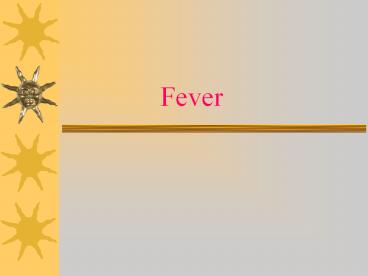Fever - PowerPoint PPT Presentation
1 / 41
Title: Fever
1
Fever
2
(No Transcript)
3
Normal
- Axillary temperature 3637 .0 ?C
- Sublingual temperature 36.737.7 ?C
- rectal temperature 36.937.9 ?C
4
- ?? Concept
- pyrogen set point of the thermoregulatory
center body temperature
5
-
sport - physiological T pregnancy
-
luteal phase -
hyperthermia - pathological T (set point )
-
fever
T
6
- Hyperthermia
- thermogenesis
- thermolysis
- dysfunction of thermoregulatory center
7
- ?? Causes and pathogenesis of fever
- Pyrogen and activator of fever
- Activator the substance can activate the
cells that can produce the pyrogen. - pyrogen the substance can cause fever
8
Activators of fever
-
microbe G- LPS, ET -
G peptidoglycan -
virus enveloped virus -
particletransfuse response - 2. internal production
- immune
complexes -
etiocholanolone
1. Extragenou pyrogen
9
Endogenou pyrogen(EP)
- interleukin-1(IL-1)
MC,fibroblast - IL-6T,B lymphocyte,tumor
cell - TNF
- TNFa Mf
- TNFß (lymphotoxin)
active T - interferon ( IFN ) T
lymphocyte
10
(No Transcript)
11
Producing and releasing of EP
trigger NF-?B
12
sCD14
LPS sCD14 complexes
T
13
- ??Mechanism increase of set point
- 1.the pathway EP entry temperature
- center
14
Pathways of EP signal transduction to the
thermoregulation center
- a. blood brain barrier
Cell of Producing EP
Activator
EP
Activator
Activator
Activator
blood brain barrier
SP?
T?
15
- a.OVLT(organum vasculosum laminace terminalis)
16
- O V L T
-
MC - capillary
- POAH EP
- neuron
- third ventricles of brain
- optic chiasma
17
- c. vago
- 2.The mechanism increase of set point
- a. Warm sensitive neuron thermolysis
- b. Cold sensitive neuron thermogenesis
18
- Imbalance
- Normal
- warm sensitive neuron
- cold sensitive neuron
19
Thermoregulation mechanism of fever
- ?. Thermoregulation center
- 1. The positive regulation
- preoptic anterior hypothalamus, POAH
- 2. The negative regulation
- medial amygdaloid nucleus,MAN
- ventral septal area,VSA
20
Positive regulation mediators
- 1.PGE2 warm sensitive neuron
- cold sensitive neuron
- Effective medicineAsprin,buprofen (Fenbid)
- 2.CRH(corticotrophin releasing hormone)
- EP (IL-1ß, IL-6 ) CRH media fever
- TNFa, IL-1 a PGE2 media fever
SP
21
- 3. cAMP SP
- EP hypothalamus Na /Ca2
cAMP -
SP - 4. Na /Ca2
- 5. NO
- a. Activate metabolism Brown fat
- b. Inhibit Negative regulation mediators
- c. OVLT
- POAH T
22
Negative regulation mediators
- Negative feedback
- Febrile ceiling lt 42?
- endogenous cryogens
- AVP
- a-MSH
T center
T
23
??period and metabolism of fever
- The period of febrile
- 1.the fervescence period
- characteristic thermogenesisgtthermolysis
- chill
- brown adipose
tissue(scapula -
,large vessle of thoracicand -
cervical - metabolic rate
Thermogenesis
24
Manifestation
- pale , gooseflesh, chill
- warm sensitive neuron (POAH)
- Chill center
- Chill cold sensitive neuron (POAH)
cold stimuli - Chill center
- Chill
skin T
25
- Chill
- Rubro nucleus
- Lateral spinothalamic tract
- Rubrospinal tract Reticulospinal tract
- anterior motor cells
Up
Down
26
2.the persistent febrile period
- The temperature reaches the new set
point - ? Thermogenesis thermolysis
- SP on higher level
- ?Manifestation
- febrile , headache
- metabolic rate and pulse
rate - anorexia(??)
27
3.The defervescence period
- ? characteristic
- Thermogenesis lt thermolysis
- SP is reset to the normal level
- ? Manifestation
- the skin is warm and flush, sweat
28
- fervescence persistent
defervescence
set point period period
period -
39?
- 38? T
- 37?
-
time
29
metabolism change of fever
- 1. Glycometabolism
- Glycogenolysis Glycogen storage
- 2. Fat metabolism
- lipodieresis Fat storage
- Ketosis??
magersucht - 3. proteometabolism
- Protein catatabolism, negative nitrogen
- 4. water\eletrolyte metabolism\vitamin
30
- metabolism
- T 1 ? metabolism rate 13
- acute phase response
- WBC
31
Physiological changes
- 1.CNS headach , dizzy,drowsiness,
- febrile convulsion 24h
- inheritance
- hypoxia
- discharge
32
- 2.immunity system
- IL-1 activator of lymphocyte
- IL-6differentiation factor
- IFN humoral factor
- TNF anti-tumor
33
- 3.Digestion system
- Sympathetic digestive
juice - EP hypothalamus
- nauseated,vomit
- abdorminal
distention - constipation
34
- 4. circulation system
- HR 1 ? HR 18/min
- CO
- induce heart failure
- 5. Respiratory system
35
- ??principal of treatment
- 1.medicine
- Inhibit production of pyrogen glucocorticoid
inhibit IL-6 and TNF - Inhibit production of PGs
- salicylic mezolin
- 2. physics brain
- 1g water 2.5KJ(lose)
36
50
12
37
Advantage and disadvantage
- 1.disadvantage
- 2. Advantage
- Signal
- malaria
38
Case
- A 36-year-old man, One day prior to admission
he was made worse by headach ,dizzy,aching pain
and fever. - Check
- T 39?,P100/min,R 20/min,Bp 100/70mmHg,congestion
of throat,swelling of tonsil,respitatory
rudeness,no bubbling sound
39
Lab findings
- WBC13.3109/L,lymphocyte
- 16, neutrophil 83?
- Treatment
- He was given antibiotic.
- During transfusion, the patient suffer from
chilly, shake, dysphoria and tempreture rose to
T41.3?, - P120/min, R 24/min,
- Dexamethasone intravenous injection
40
Questions
- 1.What pathogenic mechanism account for this
patients fever? - 2.Why the patient shown chilly , shake, dysphoria
and tempreture rose more? - 3.How to treat and give medical order of nursing?
41
(No Transcript)

